Really special hinds
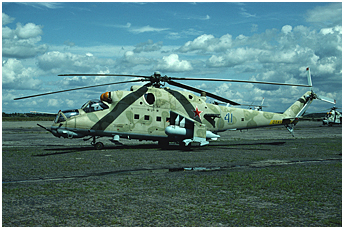
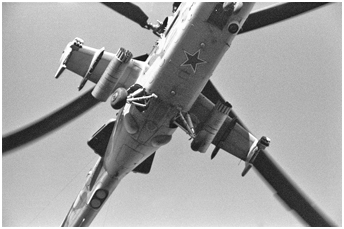 It was in April 1986, during the broadcast of a report on the consequences of the explosion of reactor N°4 at the infamous Ukrainian nuclear power plant at Chernobyl, that Western
observers identified for the first time a new version of the Mi-24 that they called "Hind-G1." The nuclear, biological and chemical (NBC) reconnaissance variant of the Mi-24 was designed
and developed to replace the Mi-8VD that had flown radiological reconnaissance missions since the mid-seventies, and the old radiological and chemical reconnaissance Mi-2RKhR version of which
the presence in the GDR was not confirmed.
The prototype of the Mi-24R (R for Razvedchik - reconnaissance) also sometimes called RKhR (Radiatsionno-Khimicheskaya Razvedka - radiological and chemical reconnaissance)
(1) was built in late 1978 from a Mi-24V airframe, but it seems that the series-produced Mi-24R were based on the Mi-24D airframe.
The number of helicopters produced between 1983 and 1989 varies from 110 to 160 according to sources.
The Mi-24R could be distinguished from its compatriots by many external features. The Raduga weapons system was absent from this version: the guidance antenna for
anti-tank missiles and the target aiming and acquisition systems were not mounted under the left and the right side of the nose, respectively. However, the "Hind-G1" still retained
some offensive capability with its USPU-24 nose turret and its weapon pylons under which rocket pods were often hung on a routine basis. Nevertheless, the S-13 strike camera usually
mounted at the left wingtip was not retained on that Mi-24 variant.
It was in April 1986, during the broadcast of a report on the consequences of the explosion of reactor N°4 at the infamous Ukrainian nuclear power plant at Chernobyl, that Western
observers identified for the first time a new version of the Mi-24 that they called "Hind-G1." The nuclear, biological and chemical (NBC) reconnaissance variant of the Mi-24 was designed
and developed to replace the Mi-8VD that had flown radiological reconnaissance missions since the mid-seventies, and the old radiological and chemical reconnaissance Mi-2RKhR version of which
the presence in the GDR was not confirmed.
The prototype of the Mi-24R (R for Razvedchik - reconnaissance) also sometimes called RKhR (Radiatsionno-Khimicheskaya Razvedka - radiological and chemical reconnaissance)
(1) was built in late 1978 from a Mi-24V airframe, but it seems that the series-produced Mi-24R were based on the Mi-24D airframe.
The number of helicopters produced between 1983 and 1989 varies from 110 to 160 according to sources.
The Mi-24R could be distinguished from its compatriots by many external features. The Raduga weapons system was absent from this version: the guidance antenna for
anti-tank missiles and the target aiming and acquisition systems were not mounted under the left and the right side of the nose, respectively. However, the "Hind-G1" still retained
some offensive capability with its USPU-24 nose turret and its weapon pylons under which rocket pods were often hung on a routine basis. Nevertheless, the S-13 strike camera usually
mounted at the left wingtip was not retained on that Mi-24 variant.
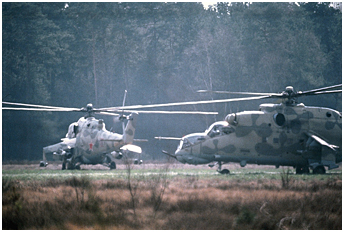 The two square windows of the right double cargo door had given way to a long rectangular rounded window that improved lighting at the workplace located there, while allowing
better observation outside the helicopter. The sealing of the Mi-24R was enhanced and the air entering the cabin was captured and filtered through a dedicated device. It presented
itself externally in the form of a cylindrical protrusion visible under the front left of the nose, behind the nosewheel well. That fairing shrouded the air intake fan that drew air
into the purification system before injecting it into the cabin. The rectangular exhaust slit for the foul air was visible just above, on the left side of the fuselage. The crew was
protected by sheets of lead added to the coating of the helicopter. A flare markers launcher with ten color cartridges used to indicate the contaminated areas was attached to the tailskid
under the end of the tailboom.
The two square windows of the right double cargo door had given way to a long rectangular rounded window that improved lighting at the workplace located there, while allowing
better observation outside the helicopter. The sealing of the Mi-24R was enhanced and the air entering the cabin was captured and filtered through a dedicated device. It presented
itself externally in the form of a cylindrical protrusion visible under the front left of the nose, behind the nosewheel well. That fairing shrouded the air intake fan that drew air
into the purification system before injecting it into the cabin. The rectangular exhaust slit for the foul air was visible just above, on the left side of the fuselage. The crew was
protected by sheets of lead added to the coating of the helicopter. A flare markers launcher with ten color cartridges used to indicate the contaminated areas was attached to the tailskid
under the end of the tailboom.
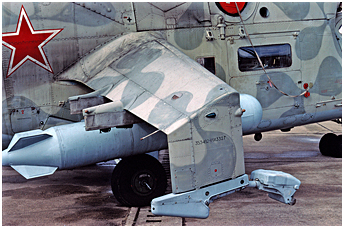 But the Mi-24R characteristic that made a mark on everyone's minds was located at the end of the wings: the ATGM missile rails of the previous Mi-24 combat models had given way
to an ingenious removable device used to take soil samplings. The latter was identified at the time by the Western intelligence services as some electronic equipment... This system
consisted of a group of three small mobile probes placed at the end of an articulated mechanical arm that could be lowered to the ground when the helicopter had landed. It was thus
possible to take six soil samples for later analysis. Two workstations were installed in the aft cargo compartment. An operator sat in the right front facing an FO-1 console near the
rectangular window. The FO-1 was used to process the data collected from the analysis and to send encoded messages. The second operator who also functioned as the mission chief was
responsible for the transmission of the collected information to command posts and ground troops.
But the Mi-24R characteristic that made a mark on everyone's minds was located at the end of the wings: the ATGM missile rails of the previous Mi-24 combat models had given way
to an ingenious removable device used to take soil samplings. The latter was identified at the time by the Western intelligence services as some electronic equipment... This system
consisted of a group of three small mobile probes placed at the end of an articulated mechanical arm that could be lowered to the ground when the helicopter had landed. It was thus
possible to take six soil samples for later analysis. Two workstations were installed in the aft cargo compartment. An operator sat in the right front facing an FO-1 console near the
rectangular window. The FO-1 was used to process the data collected from the analysis and to send encoded messages. The second operator who also functioned as the mission chief was
responsible for the transmission of the collected information to command posts and ground troops.
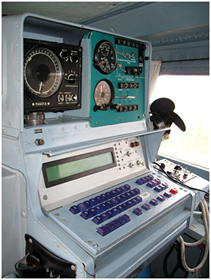 He also managed the various sampling and analysis equipment installed in the compartment, which included:
He also managed the various sampling and analysis equipment installed in the compartment, which included:
- A RAP-1 (GO-21) device to measure exposure to gamma rays included in a scale ranging from 0.01 to
100 Roentgen per year
- A PRKhR (GO-27) recognition system of chemicals and radiation for the detection and the continuous
monitoring of gamma rays and measuring the degree of exposure to toxic substances such as sarin
- A GSA-12 (GO-74) gas detector for automatic monitoring of the environment to detect
organophosphorus vapors
- An ASP automatic alarm for the detection of toxic aerosols and the continuous monitoring of ambiant
air
- A PPKhR semi-automated chemical recognition system to detect toxic substances such as soman,
phosgene, diphosgene, cyanide, cyanogen chloride or mustard gas
- The mobile probes at the end of wings mentioned above
The Mi-24R regularly carried a mysterious container under the BD3-57KrV left outer wing pylon. In the absence of information, the function of the latter was the subject of numerous presumptuous interpretations during the Cold War and beyond. It was in fact an ordinary transport pod with two side doors. If the container was nothing extraordinary, its contents were out of the ordinary:
 - A VPKhR military chemical recognition case to collect samples
- A VPKhR military chemical recognition case to collect samples
- A DP-5B dosimeter
- A KPO-1 bag with the appropriate equipment to collect material samples
contaminated by radiation or chemical and bacteriological substances
- A TDP degasification set to decontaminate equipment
- SKhT-40chemical alert rockets (visual and audible markers)
- RDG-2 smoke grenades
Carrying of the following equipment was also considered but not selected:
- A bag containing a MK-3 meteorological complex composed of instruments used to
determine the air and ground temperatures, and the wind conditions on small plots
of land
- A R-147 radio with a range of one kilometer
All that equipment was used to take samples and mark contaminated areas on the ground, outside the helicopter, when that was not possible while staying aboard the helicopter. It was also preferable, at least psychologically, to keep these potentially contaminated items after use inside a container located outside the helicopter rather than inside the compartment... Onboard survival equipments included two portable oxygen tanks, two more oxygen bottles equipped with their KKO-LS respiratory system, Yasen-A gas masks and Kompakt-A protective suits.
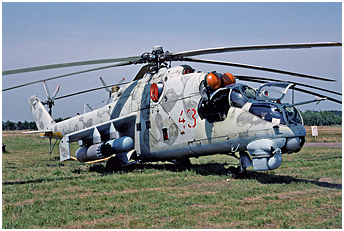 Although they were not fulfilling the same type of mission, one could say that the Mi-24K did not go without the Mi-24R and vice versa! Indeed, generally there were the same number
of each version within the same unit. It is also interesting to note in the USMLM Unit History report for 1986 that the first six "Hind-G1" and "-G2" observed at Neuruppin the same year,
often flew together. The Mi-24K "Hind-G2" (K for Korrektirovschik - adjustment) was nevertheless a specialized variant used for reconnaissance, battlefield observation,
photography and artillery correction (determination of target coordinates, fire correction and observation of missile impacts when that was not possible from the ground).
The airframe of the Mi-24K was based on that of the Mi-24V. The number of copies produced between 1983 and 1989 is somewhat uncertain (92 or 170 ...). It replaced the Mi-8TARK, which
executed the same tasks. Like the Mi-24R, the "Hind-G2" had lost its antitank capabilities but retained its weapon pylons.
Although they were not fulfilling the same type of mission, one could say that the Mi-24K did not go without the Mi-24R and vice versa! Indeed, generally there were the same number
of each version within the same unit. It is also interesting to note in the USMLM Unit History report for 1986 that the first six "Hind-G1" and "-G2" observed at Neuruppin the same year,
often flew together. The Mi-24K "Hind-G2" (K for Korrektirovschik - adjustment) was nevertheless a specialized variant used for reconnaissance, battlefield observation,
photography and artillery correction (determination of target coordinates, fire correction and observation of missile impacts when that was not possible from the ground).
The airframe of the Mi-24K was based on that of the Mi-24V. The number of copies produced between 1983 and 1989 is somewhat uncertain (92 or 170 ...). It replaced the Mi-8TARK, which
executed the same tasks. Like the Mi-24R, the "Hind-G2" had lost its antitank capabilities but retained its weapon pylons.
 A new device, however, was located in lieu of the target acquisition and aiming system usually mounted on 'D', 'V' and 'P' versions. It was a turret containing an Iris
wide-angle optical sensor that was protected at rest by a large cover opening upward. A set of mobile mirrors allowed a greater field of view of the system that was +/- 110° in the
horizontal and -20°/+15° in the vertical plane. The operator seated in the front (there was no additional crew member inside the cargo compartment aboard the Mi-24K) could see targets
with the optical sensor through a periscope system reminiscent of the Raduga.
In addition to observing the battlefield, this operator had the option to point a cursor on a target to automatically correct any coordinate errors. The information were sent to ground
troops via a R-828 VHF radio. The Iris was part of the Ruta complex that included an Orbita-20-9K digital computer to manage the system. The presence in the
front cockpit of a folding table for cards and controls for the Iris and Ruta prevented retention of the flight controls usually available to the aviator-operator,
the Russian term for the crew member occupying the front position.
A new device, however, was located in lieu of the target acquisition and aiming system usually mounted on 'D', 'V' and 'P' versions. It was a turret containing an Iris
wide-angle optical sensor that was protected at rest by a large cover opening upward. A set of mobile mirrors allowed a greater field of view of the system that was +/- 110° in the
horizontal and -20°/+15° in the vertical plane. The operator seated in the front (there was no additional crew member inside the cargo compartment aboard the Mi-24K) could see targets
with the optical sensor through a periscope system reminiscent of the Raduga.
In addition to observing the battlefield, this operator had the option to point a cursor on a target to automatically correct any coordinate errors. The information were sent to ground
troops via a R-828 VHF radio. The Iris was part of the Ruta complex that included an Orbita-20-9K digital computer to manage the system. The presence in the
front cockpit of a folding table for cards and controls for the Iris and Ruta prevented retention of the flight controls usually available to the aviator-operator,
the Russian term for the crew member occupying the front position.
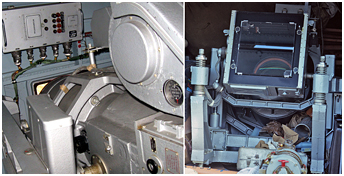
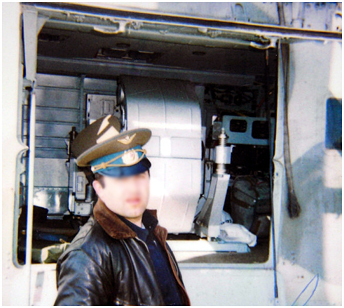 The Ruta reconnaissance suite that included a data presentation complex was located in the compartment together with a huge camera facing right and slightly down in the front.
The presence of this camera that could either be a 1300mm A-87PV or an AFA-110-280, had necessitated the removal of the
compartment access doors on the right side of the fuselatge. An optically flat rectangular window through which the camera exposed its frames was located at the bottom of the former location
of these doors. The A-87PV camera most often encountered was supplied by a huge cartridge containing 60 meters of 300x300mm film.
In addition, a SU-5 light meter was fixed behind the first window on the right side of the camera, ensuring correct image exposures.
The films were developed in an APF-U transportable laboratory. A laser designator was sometimes carried instead of a camera.
The Ruta reconnaissance suite that included a data presentation complex was located in the compartment together with a huge camera facing right and slightly down in the front.
The presence of this camera that could either be a 1300mm A-87PV or an AFA-110-280, had necessitated the removal of the
compartment access doors on the right side of the fuselatge. An optically flat rectangular window through which the camera exposed its frames was located at the bottom of the former location
of these doors. The A-87PV camera most often encountered was supplied by a huge cartridge containing 60 meters of 300x300mm film.
In addition, a SU-5 light meter was fixed behind the first window on the right side of the camera, ensuring correct image exposures.
The films were developed in an APF-U transportable laboratory. A laser designator was sometimes carried instead of a camera.
At the time of withdrawal from Germany, the Mi-24R and K were assigned to separate combat and control helicopter squadrons (OVE BU) assigned to armies, with two of each version in each unit,
and to separate combat and control helicopter regiments (OVP BU) with two helicopters of each variant per squadron.
 Un Mi-24K à gauche, accompagné d'un Mi-24D en mission au-dessus de la RDA. © AMLM.
Un Mi-24K à gauche, accompagné d'un Mi-24D en mission au-dessus de la RDA. © AMLM.A Mi-24K (at left) flying together with a Mi-24D above the GDR. © AMLM. |
 |
Mi-24 PHOTO PAGE |  |
notes
(1) Sometimes designated erroneously Mi-24RKh, KhR or RKR.
 |
The Mi-24 < Part 1 | < Part 2 |
 |
Plan du site - Sitemap |  |
